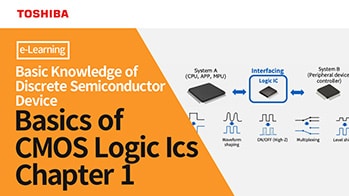- General Top
- SEMICONDUCTOR
- STORAGE
- COMPANY
-
My ToshibaSemicon
- Semiconductor Top
-
ApplicationsAutomotive
Body Electronics
xEV
In-Vehicle Infotainment
Advanced Driver-Assistance Systems (ADAS)
Chassis
IndustrialInfrastructure
BEMS/HEMS
Factory Automation
Commercial Equipment
Consumer/PersonalIoT Equipment
Healthcare
Wearable Device
Mobile
Computer Peripherals
-
ProductsAutomotive Devices
Discrete Semiconductor
Diodes
Transistors
Logic ICs
Analog Devices
Digital Devices
Wireless Devices
※
: Products list (parametric search)
Power SemiconductorsSiC Power Devices
※
: Products list (parametric search)
Isolators/Solid State RelaysPhotocouplers
Digital Isolators
Solid State Relays
Fiber Optic Transmitting Modules
※
: Products list (parametric search)
MOSFETsIGBTs/IEGTsBipolar Transistors※
: Products list (parametric search)
Diodes※
: Products list (parametric search)
MicrocontrollersMotor Driver ICsIntelligent Power ICs※
: Products list (parametric search)
Power Management ICsLinear ICs※
: Products list (parametric search)
General Purpose Logic ICsLinear Image SensorsOther Product ICsOther Product ICs
※
: Products list (parametric search)
-
Design & Development
-
Knowledge
- Where To Buy
- Part Number & Keyword Search
- Cross Reference Search
- Parametric Search
- Stock Check & Purchase
This webpage doesn't work with Internet Explorer. Please use the latest version of Google Chrome, Microsoft Edge, Mozilla Firefox or Safari.
require 3 characters or more. Search for multiple part numbers fromhere.
The information presented in this cross reference is based on TOSHIBA's selection criteria and should be treated as a suggestion only. Please carefully review the latest versions of all relevant information on the TOSHIBA products, including without limitation data sheets and validate all operating parameters of the TOSHIBA products to ensure that the suggested TOSHIBA products are truly compatible with your design and application.Please note that this cross reference is based on TOSHIBA's estimate of compatibility with other manufacturers' products, based on other manufacturers' published data, at the time the data was collected.TOSHIBA is not responsible for any incorrect or incomplete information. Information is subject to change at any time without notice.
require 3 characters or more.
What is the difference between CMOS logic IC multiplexers and bus switch multiplexers?
A CMOS logic IC multiplexer is a device that outputs a signal from one selected output terminal from multiple input signals. Since the output is CMOS structure, it has drive-ability and is not easily affected by the load in the later stage. The signals that can be handled are digital signals, and signal transmission is unidirectional (input → output). On the other hand, the bus switch multiplexer also outputs one signal from multiple input signals. It is easily affected by noise and is mainly used for signal blocking and switching. Both digital and analog signals can be handled. In addition, signals can be transmitted in both directions.

CMOS logic IC Multiplexers
A simple example is the TC74HC257 (4-circuit 2-channel multiplexer).
Select either the signal from the A terminal or the signal from the B terminal by the input signal level of the SELECT terminal, and output from the Y terminal.

Bus switch Multiplexers
TC7SB3157 (1-circuit 2-channel multiplexer) is used as an example.
Select the A-B1 route or A-B2 route with the input signal level of the S terminal (SELECT terminal). Signals can be transmitted in both directions.
Related Links
The following documents also contain related information.




